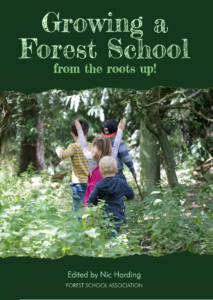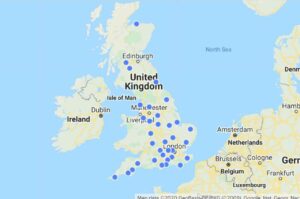The benefits of tree climbing are enormous. Being off the ground provides children with the opportunity to challenge themselves whilst having fun and exercise. Climbing trees brings children into close contact with nature and some children will find being in trees calms them. Climbing trees also stimulates the senses. For some children they will have a sense of being allowed to do something new which is often forbidden to them.
Some children can excel at this activity because they are low in body weight, fearless, and have an unlimited abundance of energy. Tree climbing is a great way to build a child’s self-confidence. (play types: deep play, locomotor play)
Climbing and being off the ground is one of the more risky activities on offer at a Forest School, it is also one of the most memorable and rewarding for the children and young people who are taking part. The benefits far outweigh the risks. With control measures in place the chance of serious harm occurring is minimized. Longevity of experience suggests that the chances of a serious accident occurring are slight and children appreciate the trust being put in them to manage their own risk taking while tree climbing.
“Climbing trees and falling out of them is all part of growing up and having small injuries helps children learn about risks. We take the view that it’s a good thing to try to equip children and young people and help them make informed decisions about the risks that they take”. ROSPA
Suggested control measures.;
1.1 during wet weather make children aware that the branches and rocks will be more slippy
1.2 children not to be put under pressure when climbing, allow children to focus on the activity and speak to them calmly and reassuringly.
1.3. Adult to climb all trees that children climb to assess risks
1.4 Children are not permitted to climb higher than 3x their height off the ground (check with insurers)
1.5 ribbons of other visual signals could be used to mark where safe climbing limit is.
2.1. Get children to ‘flag’ (verbally or physically) Dead branches and sharps
2.2. Make sure all children can recognise a dead branch by its lack of foliage, bark,
twigs or the different sound a dead branch makes (n.b this may cause
problems in winter time when there are no leaves. Look for buds or small twigs to show healthy branches)
2.3. Adult to climb all trees that children climb to double check location of dead branches
3.1. Limit numbers of children in any one tree or rock.
3.2 encourage children to be aware of others and sensitive to different abilities and the speed that others can climb
3.4 check the ground underneath the tree for sharp roots, rocks or branches
4.1. Children must only climb where they can climb unaided. Do not give ‘bunk ups’ or allow children to use climbing aids.
4.2 Allow children to focus on the activity and speak to them calmly and reassuringly.
4.3 respect children’s self imposed limits on how high they want to climb
4.4 Children are limited to height they can climb by how high adult can reach
5.1 Do not climb trees if you see
broken branches that are hanging precariously or lodged in a tree.
A leaning tree which has air spaces in the soil opposite the trees lean
Cracks in the trunk
The tree is dead or mostly dead- no foliage in summer and no buds or small twigs in winter
5.2 thoroughly assess all trees that are used for climbing:
Look at the tree from a distance to get a feel for it as a whole. Assess this each time you go back to a tree to note any changes: Be cautious about allowing tree climbing if you see the following:
Leaning which will often be more evident from afar.
Branches that are broken or split
Branch angles that look out of place or unusual.
Power lines are often seen more clearly from a distance.
Large dead branches in the top of the tree
Look at the trunk and the floor. Assess this each time you go back to a tree to note any changes: Be cautious about allowing tree climbing if you see the following:
Dead branches lying on the ground. It’s a good bet there will be more of them up in the tree. Step away from the tree and look up again.
The presence of fungus on or near a tree trunk. This points to root decay and trunk rot
Absence of bark on the trunk which indicates a dead section or a fungus attack.
A long streak of missing bark coming down the trunk which usually means lightning has hit the tree.
5.3 If unsure of the status of a tree or the risk it poses ask for advice or professional opinion.
Expert Sources: Royal Society for the Prevention of Accidents in the UK , Tree Climbers International.





Aline Hill
The benefits of tree climbing listed are undeniable. I’m not sure they’re what I’d have identified as a child (as far as my own memories go).
I wondered if anyone had material from children or from their own memory on other benefits of tree climbing? I’d love to see it!
I definitely remember having a special tree that I climbed at the end of the garden – a grown-out tree at the corner of a beech hedge. . I think I climbed it often (daily? weekly?) over a number of years. It had a roped-together platform at roughly twice my height that I’d built out of carpenters off cuts . It had a tiny high platform at least my height again, made of one small board.
Benefits?
I remember the feeling of calm, and sense of drifting amongst the breeze-bounced leaves. I’m feeling that a bit as I’m remembering it.
I remember feeling as much as though I was in the sky as connected to the ground. I felt bodily connected.
I often pretended I was at sea. I called the high platform the crow’s nest and loved to ride it in the wind. When I discovered that mistle trushes do similar, singing, I felt a strong sense of affinity and admiration.
I used to plan what I’d need, put it in my lunchbox tied to a rope, climb the tree, then pull up my box – I think it usually had food in it, sometimes books, and, at least once, some origami water bombs.
I always climbed it by the same route, and descended by the same alternative route.
… tbc